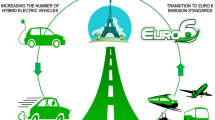Abstract
This paper examined the impact of transportation energy policies on traffic safety through policy simulations. Considering the changes in the vehicle miles traveled (VMT) and in vehicle stock composition as a result of policy changes, the impacts of these changes on traffic accidents were examined in terms of the number of traffic accidents, traffic fatalities, and total accident costs. The main focus was on the following policy alternatives: Fuel tax, mileage based a VMT tax, Pay-as-you-drive (PAYD) and Pay-at-the-pump (PATP) insurance premium policy, and the Corporate Average Fuel Economy (CAFE) standards regulations. By integrating three interrelated economic demand decisions fully (size of the vehicle stock, use of the vehicle stock, and energy efficiency), the short-run, long-run and dynamic effects of a policy change can be predicted. The results showed that the share of light trucks will keep increasing in the future in all policy alternatives and that fuel consumption will decrease compared to the baseline in every scenario except for the VMT tax policy. The results also show that the fatality rates per vehicle miles traveled will decrease, but the CAFE policy will result in more fatalities and higher fatality rates compared to the baseline scenario. The results may provide guidance as to what would reduce the energy dependency while reducing the undesirable side effects related to traffic safety. The outcomes of this research will provide a set of specific results comparing policy scenarios in a consistent manner. The results will provide guidance as to whether the policy option would improve energy dependency while reducing the undesirable side effects, such as the problems related to the environment and the safety of motor vehicle travel.




Similar content being viewed by others
Notes
Transportation Energy Data Book (26), Table 2.7, Table 4.17, and 4.18.
For the purposes of compiling the DOT safety statistics, a fatality is defined as any injury that results in death within 30 days of a transportation crash, accident, or incident.
Mass and weight are assumed to be interchangeable despite, conceptually, the two terms being distinct.
Appendix 1 presents the full structural model based on system equations (1) and the estimation results.
By further defining a κ ij as the accident involvement rate of crash severity κ (κ = F (fatality), H (injury), P (property damage only)), the number of vehicles involved can also be calculated according to the crash severity.
The probability of a car-car crash, for example, can be calculated from the equation, \( p\left(C,C\right)=\left(\begin{array}{c}\hfill {V}_{C2}\hfill \\ {}\hfill 2\hfill \end{array}\right)/\left(\begin{array}{c}\hfill {V}_2\hfill \\ {}\hfill 2\hfill \end{array}\right) \), where \( \left(\begin{array}{c}\hfill {V}_{C2}\hfill \\ {}\hfill 2\hfill \end{array}\right) \) denotes the combination function of choosing two vehicles out of the number of VC2 and, by definition, \( \left(\begin{array}{c}\hfill {V}_{C2}\hfill \\ {}\hfill 1\hfill \end{array}\right)={V}_{C2} \).
Busse et al. [3] examined the effects of fuel prices on car prices and market shares. They estimate the effect of fuel prices on new light duty vehicle shares with more segments of the LDV types (i.e. Compact, Midsize, Luxury, Sports, SUV, Pickup, and Minivan) using a linear probability model.
References
Ahmad S, Greene DL (2005) Effect of fuel economy on automobile safety: a reexamination. Trans Res Rec 1941(1):1–7
Brozović, N, Ando AW (2005) Defensive purchasing, the safety (dis)advantage of light trucks, and motor-vehicle policy effectiveness. Working Paper, University of Illinois at Urbana-Champaign
Busse M, Knittel C, Zettelmeyer F (2008) Fuel prices and automobile purchasing. Presented at the University of California Energy Institute (UCEI)
Crandall RW, Graham JD (1989) The effect of fuel economy standards on automobile safety. J Law Econ 32(2):97–118
Evans L (1984) Accident involvement rate and car size. Acc Anal Prevent 16(5–6):387–405
Evans L (2004) Traffic safety. Science Serving Society, Bloomfield Hills, 2004
Federal Highway Administration (FHWA) (2004) Highway Statistics, Federal Highway Administration, U.S. Department of Transportation
Godek PE (1997) The regulation of fuel economy and the demand for “light trucks”. J Law Econ 40(2):495–510
Gordon P, Richardson HW, Wong HL (1986) The distribution of population and employment in a polycentric city: the case of los angeles. Environ Plan A 18(2):161–173
National Highway Traffic Safety Administration (NHTSA) (2002) The economic impact of motor vehicle crashes 2000. National Highway Traffic Safety Administration, Washington DC
National Highway Traffic Safety Administration (NHTSA) (2005) Traffic safety facts 2004. National Highway Traffic Safety Administration, Washington DC
Noland RB (2005) Fuel economy and traffic fatalities: multivariate analysis of international data. Energy Policy 33(17):2183–2190
Parry IWH, Fischer C, Harrington W (2004) Should corporate average fuel economy (CAFE) standards be tightened? Discussion Paper # 04–53, Resources for the Future, Washington DC
Ross M, Wenzel T (2001) Losing weight to save lives: A review of the role of automobile weight and size in traffic fatalities. Tech. Rep. LBNL–48009, American Council for an Energy-Efficient Economy (ACEEE)
Small K, Van Dender K (2005) A study to evaluate the effect of reduce greenhouse gas emissions on vehicle miles traveled. Final report, California Air Resources Board
Small K, Van Dender K (2007) Fuel efficiency and motor vehicle travel: the declining rebound effect. Energy J 28:25–51
U.S. EPA (2005) Emission facts: greenhouse gas emissions from a typical passenger vehicle. U.S. Environmental Protection Agency, EPA420-F-05-004, Washington DC
White MJ (2004) The “arms race” on American roads: the effect of sport utility vehicles and pickup trucks on traffic safety. J Law Econ 47:333–355
Author information
Authors and Affiliations
Corresponding author
Appendices
Appendices
1.1 Appendix 1: estimates of system equations
We estimate the full structural model based on system equations (1) and Table 3 shows the estimation results. Formally, then, the system is the following:
with error terms following the rule
See Small and Van Dender [16] for data sources and detailed description of how the variables were generated and estimated.
Appendix 2
Rights and permissions
About this article
Cite this article
Kim, CK., Chung, K., Kim, Y. et al. The effects of transportation energy policy on fuel consumption and transportation safety. Multimed Tools Appl 74, 2535–2557 (2015). https://doi.org/10.1007/s11042-014-1974-6
Published:
Issue Date:
DOI: https://doi.org/10.1007/s11042-014-1974-6




